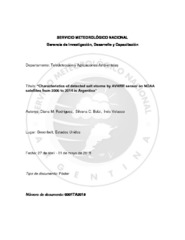Mostrar el registro sencillo del ítem
Characteristics of detected salt storms by AVHRR sensor on NOAA satellites from 2006 to 2014 in Argentina
| dc.contributor.author | Bolzi, Silvana Carina | |
| dc.contributor.author | Rodríguez, Diana Marina | |
| dc.contributor.author | Velasco, Inés | |
| dc.date.accessioned | 2016-10-04T18:26:44Z | |
| dc.date.available | 2016-10-04T18:26:44Z | |
| dc.date.issued | 2015-04-27 | |
| dc.identifier.uri | http://hdl.handle.net/20.500.12160/33 | |
| dc.description.abstract | Salt storms only happen in places where there are large deposits of salt on the ground, like those around the Aral Sea in Central Asia, the Great Salt Lake in the United States of America and in the Mar Chiquita Lake, Argentina. These storms are low clouds whose development is similar to dust storms, except for the characteristics of the soil where they originate. Since 2003 the Laguna Mar Chiquita began a period of regression, exposing large areas of land covered with salt. The observations from space with different satellites allowed to document the presence of very white salt clouds originated when fine sediments around the lake perimeter are easily lofted into the air by winds. The occurrence of salt storms near Mar Chiquita from 2006 to 2014 was documented using satellite images captured by sensor AVHRR on NOAA 17, 18 and 19 satellites and downloaded by the receiving station at the Argentina´s Meteorological Service. The observed clouds have different levels of development, from a weak plume to a thick cloud of great extent. The number of observed events varies from year to year and also during the year. Most of the observed storms occurred in the winter months with the winds blowing almost exclusively from the north or south. A number of salt events were analyzed using data from two reflective and two infrared thermal AVHRR bands. Some results for the event on July 8, 2012 are presented. It is found that salt clouds are more reflective than the background soil, but less reflective than water or ice clouds, probably because salt clouds have less optical thickness and brightness temperature difference (BTD) (11 m minus 12 m) is always negative. Then it could be used for the identification of salt storm outbreak and for the estimation of the spatial extent developed and also for automatic salt storm identification in daytime and night time conditions. | es |
| dc.language.iso | spa | es |
| dc.publisher | Servicio Meteorológico Nacional | es |
| dc.subject | TORMENTAS DE SAL | es |
| dc.subject | NUBES DE SAL | es |
| dc.subject | NOAA | es |
| dc.subject | AVHRR | es |
| dc.subject | LAGUNA MAR CHIQUITA | es |
| dc.subject | CORDOBA | es |
| dc.title | Characteristics of detected salt storms by AVHRR sensor on NOAA satellites from 2006 to 2014 in Argentina | es |
| dc.type | Other | es |
